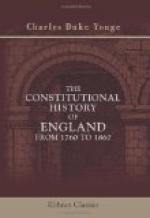[Footnote 22: In his “Lives of the Chief-justices” (c. xxxvi., life of Lord Mansfield), Lord Campbell says, with reference to this case: “The Chief-justice’s only considerable public exhibition during this period was his attack on the unconstitutional assertion of Lord Chatham and Lord Camden, that, in a case of great public emergency, the crown could by law dispense with an act of parliament. The question arising from the embargo on the exportation of corn, in consequence of apprehended famine, he proved triumphantly that, although the measure was expedient and proper, it was a violation of law, and required to be sanctioned by an act of indemnity.” And Lord Campbell adds, in a note: “This doctrine, acted upon in 1827, during the administration of Mr. Canning, and on several subsequent occasions, is now universally taken for constitutional law” (ii., 468).]
[Footnote 23: To adduce a single instance, worthy of remark as affecting the personal liberty of the subject, in 1818 a bill of indemnity was passed to sanction the action of the ministry in arresting and detaining in prison, without bringing them to trial, several persons accused of being implicated in seditious proceedings (vide infra).]
[Footnote 24: Vol. xvii., 304.]
[Footnote 25: The case is mentioned by Lord Campbell in his “Lives of the Chancellors,” c. cxxi. (life of Lord Macclesfield) and c. cxxiv. (life of Lord Chancellor King).]
[Footnote 26: In fact, however, the age at which a young prince was considered competent to exercise the royal authority in person had been fixed at eighteen; and it is so stated in the speech in which the King, in 1765, recommended the appointment of a Regent to Parliament.— Parliamentary History, xvi., 52.]
[Footnote 27: This idea was expanded into an epigram, which appeared in most of the daily papers, and has been thought worthy of being preserved in the “Parliamentary History,” xvii., 401 (note):
“Quoth Dick to Tom, ’This
act appears
Absurd, as I’m alive,
To take the crown at eighteen years,
A wife at twenty-five.
The mystery how shall we explain?
For sure, as Dowdeswell said,
Thus early if they’re fit to reign,
They must be fit to wed.’
Quoth Tom to Dick, ’Thou art a fool,
And nothing know’st
of life;
Alas! it’s easier far to rule
A kingdom than a wife.’”]
[Footnote 28: It is remarkable that this clause on one occasion proved an obstacle to the punishment of the abettors of such a marriage. In 1793 the Duke of Sussex married Lady Augusta Murray, first at Rome, and afterward, by banns, at St. George’s, Hanover Square. And when the affair came to be investigated by the Privy Council, Lord Thurlow denounced the conduct of the pair in violent terms, and angrily asked the Attorney-general, Sir John Scott, why he had not prosecuted all the parties concerned in this




